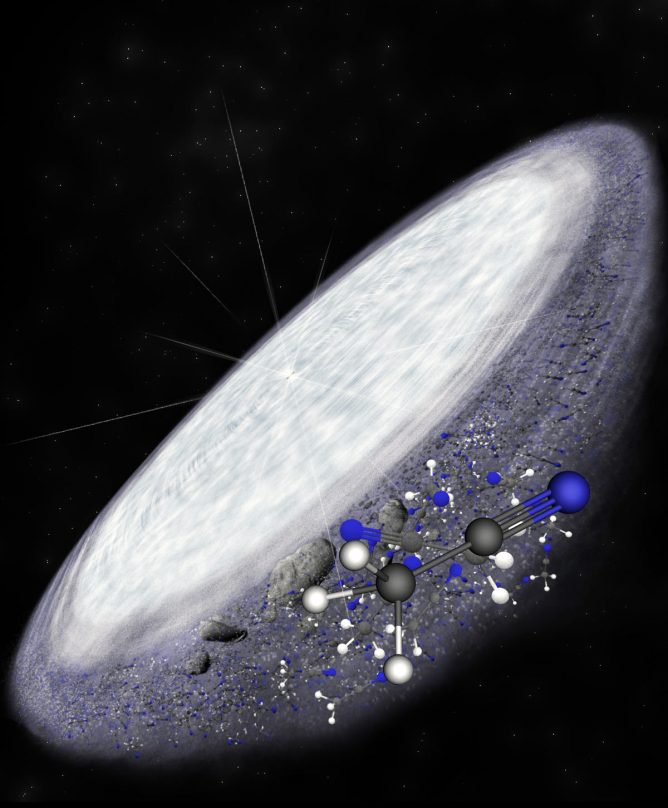2017.05.09
Interview with ALMA Public Outreach Officer : Mysteries of the Universe vol.1 Can Life Exist on Other Planets?
One of the scientific goals of ALMA is to explore building blocks of life. What is the likelihood of the existence of Earth-like planets and extraterrestrial life? To find the answer for simple questions like this and know more about the mechanism of the universe, we interviewed with ALMA EPO officer Masaaki Hiramatsu.
Interviewed and written by Toshihiro Nakamura
Photographed by: Nozomu Toyoshima
Is there Many Planets with Life in the Universe?
— How many stars and galaxies have been found in astronomy so far?
Hiramatsu: Our Earth exists in the Milky Way Galaxy with roughly 100 billion stars. And it is assumed there are several hundreds of billion galaxies in the universe like ours.
— That means the number of stars in the whole universe would be 100 billion times several hundreds of billion?
Hiramatsu: Could be, in a simple calculation. I’d like to introduce you this very useful Window’s software (Mitaka). This software reproduces the galaxies and stars that have been found in astronomy in three dimensions with their positional information.

The universe around our solar system displayed with Mitaka
Credit:4D2U Project, NAOJ. All rights reserved.
— Wow…amazing. This image makes me a little crazy (laugh). Among such an enormous number of stars in the universe, planets with life like the Earth have yet to be found. Is there any chance that it will be found in the future?
Hiramatsu: We can’t say anything for sure because we only know about the life on earth. But, personally I won’t be surprised even if life is found somewhere in the universe with such a huge number of stars (indicating the screen shown by the application software).
— What kind of life do you think does exist beyond the Earth? Like aliens that live in more advanced civilizations than ours?
Hiramatsu: A word of “life” means a variety of forms of life. It ranges from a very simple life like microorganism, higher organism like plants and animals, and intellectual life like human beings. But, regardless of such differences, I have no doubt about the existence of life in large quantities.

Masaaki Hiramatsu (Assistant professor at the NAOJ Chile Observatory and East-Asian ALMA EPO Officer) at the NAOJ (Mitaka)
— Why do you think that way?
Hiramatsu: Because there have been found an increasing number of potential planets that might have life. Extrasolar planets (planets outside our solar system) were found in 1995 for the first time, and since then many planets have been found around stars other than the Sun. It is said that about a half of stars shining in the night sky might have planets. Since a quite number of stars have multiple planets in their own system, I naturally think there might be a quite number of planets with life.
The Universe Filled with Building Blocks of Life
Hiramatsu: Another discovery by astronomical observations so far is that the universe is filled with building blocks of life.
— What materials could be the building blocks of life?
Hiramatsu: For example, amino acids that compose proteins have been found from meteorites fallen on earth too, which suggests possible existence of amino acids outside the Earth.
Also, in space beyond our solar system, there have been found organic molecules with bonds of carbon and oxygen which make up amino acids. ALMA already captured molecules required for the birth of life such as glycolaldehyde and methanol in planet forming regions. These discoveries are expected to be a key to reveal the origin of life.
— You mean, simple life could be easily formed from such an abundance of ingredients for life?
Hiramatsu: We have yet to know what is the probability of the birth of life as a consequence of organic molecules and amino acids bonding together. However, according to the research of life on the Earth, it is confirmed that life can survive in a very severe environment once it occurred.

— Like what kind of environment would be?
Hiramatsu: Environment with high temperature, high pressure or high radiation. For example, tardigrades also known as “water bears” thought to be “toughest creatures”. They are tiny animals of 1 mm in length. Reportedly they can withstand high temperature up to 150 degrees Celsius and cold temperature cooled to absolute zero, and high pressure up to 75,000 atmospheres in a state called “anhydrobiosis”. They survive extreme dehydration, high ultraviolet and radioactive rays, and even the vacuum of space for the period of around 10 days.
— Invincible!! So, this example shows that life, once occurred, can survive severe environment if they are tough.
Hiramatsu: This is only an assumption based on the research of life on the Earth. To know more about the probability of occurrence of life, further research will be needed in collaboration with other fields of study such as molecular biology.










